The Michel Vaillant adventure 'Champion du Monde'
The local press at Indianapolis underestimated big time
Author
- Henri Greuter
Date
- July 14, 2023
Related articles
- 1973 Indy 500 - Reviewing a golden Indy anniversary that's better not celebrated, by Henri Greuter
- Michel Vaillant - Le Grand Défi by Jean Graton, first of the Michel Vaillant comics: Some reflections and even more reflections, by Henri Greuter
- Michel Vaillant - The Michel Vaillant adventure Suspense à Indianapolis: Where fantasy and reality met - and about that reality, by Henri Greuter
Who?Gary Bettenhausen What?McLaren-Offenhauser M16C Where?Indianapolis When?1974 Indianapolis 500 |
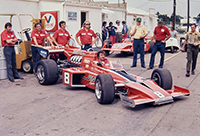 |
Why?
I must start these reflections with a few disclaimers.
No comment and no observation in this piece is meant to downgrade the work of Jean Graton. Nothing what reads as or appears to be negative must be regarded as being negative. I have no reason to be negative about Jean Graton and his work because I am one of the many readers of his albums who owe a lot of their interest for motor racing to the albums he created.
If there was a Hall of Fame for those who have promoted motor racing I will nominate Jean Graton instantly.
Secondly, it is possible that elsewhere articles like these have been published about the Vaillant albums, if not in English then perhaps in other languages. I hereby want to state, maybe must confess, that I have not done a detailed search for such articles so if there are any, I simply was not aware of their existence at the time of writing.
Then... This write-up would probably benefit from the inclusion of drawings taken from the album discussed here. Due to wanting to honour and respect the copyrights of the author and current copyright holders I can't bring myself to doing so, other than what I regard to be the absolute minimum I hope I can get away with. I hereby instantly state that the copyrights of the entire album and drawings belong to parties related with the publishers of the Michel Vaillant albums. I could list Jean Graton, Graton Editeur and Dupuis as being the rightful copyright holders. I don't want to stretch what could be seen as a possible abuse of copyrights any further than using a part of a drawing that features a car we have a closer look onto. Such details are only included in order to show the reader what cars appeared in the story while the included pictures give an impression as of where the inspiration for the drawings came from.
Finally, before I start with the actual story, I feel that I must express my sincere thanks to two men. This write-up would have remained primarily text with only a few images if it hadn't been for Mr Jim Edwards from Zionsville, IN. The majority of images used in this write-up come from the slide collection that he compiled over the years.
Regrettably, Mr Edwards's health made it necessary that his collection is by now maintained by a friend of both him and myself, Mr Bill Ashby from Brownsburg, IN. Bill provided the Jim Edwards images used in this write-up, which I think has improved big time thanks to these images.
Introduction
Since 2022, the ranking in sequence for chronology of all existing Michel Vaillant graphic novel albums that contain a link with the 500 Miles of Indianapolis is messed up. No longer the sequence of release date and the sequence of the year of the adventure taking place is similar.
The original series referred to as Season 1 has four albums in which Indianapolis is one of the venues for a race. Then there was a special dealing with the American racing scene published in 1972. That publication contained a short story about an Indy 500. Time-wise, that story fits in between the second and third of the four Season 1 novels.
Then, in 2022 the studios behind the Michel Vaillant Season 2 novels introduced a spin-off series named the Légendes. This series went back in time and had a look at genuine legendary races of the past. These races were/are to be enriched with the participation of Michel Vaillant. The very first of these Légendes deals with a genuine and original Indy 500 of the mid sixties. Time-wise this story squeezes in between the second Season 1 novel and the US racing scene special.
Since the classic Season 1 adventures are by far and away the most familiar Michel Vaillant albums, the ranking according to publication date for these albums containing Indy adventures is given priority in this series of comparing the Michel Vaillant Indy stories with the reality of Indianapolis.
Although the title of the album provides no clues for it, the 26th Michel Vaillant album titled Champion du monde is the third album drawn by Jean Graton (and part of the so-called Season 1 albums) which features an Indy 500 race in the manuscript. Should we follow the time line of all the known and published adventures, we are dealing with the fifth Indy adventure in the Michel Vaillant range.
Champion du Monde was released as an album in late 1974 and appeared in the weekly Tintin magazine from early August to early October of the same year. The story was certainly contemporary as a number of the cars as well as car-and-driver combinations that appear in the story made their debut in the 1974 season.

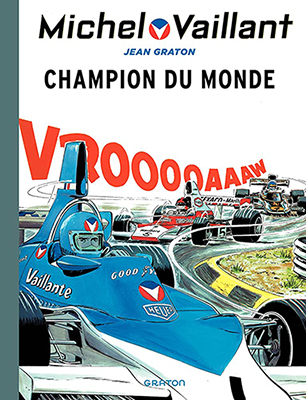
The cover of Champion du Monde had a basic design but nevertheless there were slight differences seen over the years. (copyright Graton Editeurs/Dupuis)
As for an indication as how recent the drawings of the adventure were at the time of publication, the album also has a Le Mans 24 Hours adventure, and as Le Mans traditionally takes place mid-June each year, and so in 1974 as well, one of the drawings offers a prominent view on the massive, intimidating tail end of the fearsome Martini-sponsored Porsche Carrera RSR Turbo, a car that made its race debut that year and at Le Mans that year wrote history as the first-ever car fitted with a turbocharged engine in the event. It kept on writing Le Mans history because one of the two cars made it to the finish in second place, thus becoming the first ever turbocharged car finishing a Le Mans 24 hours as well.
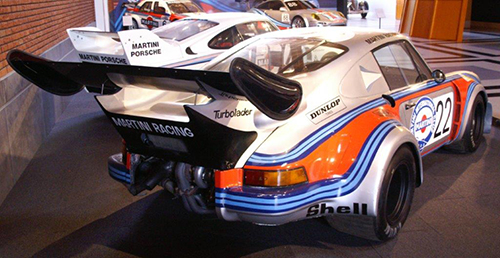
Seen here in April 2014 at the Louwman Museum at the Hague, Netherlands, one of the four examples built of what was called the Porsche Carrera RSR Turbo. This particular chassis is 911 460 9102 (R13), the most successful of the cars and the one that became the first-ever car with a turbocharged engine at Le Mans that made it to the finish. It is preserved in its historic Le Mans trim. The picture is not identical to the angle as the car appears in the drawing by Jean Graton but it gets close. For the record, the car pictured here is the sister car to the one that appears in the album.
(photo HG)
Less than six months later a graphic novel in which this car appears is for sale to the public. Compare this with the very first album Le grand défi drawn during 1957, this appeared in Tintin magazine in 1958 but was only for sale as an album one more year later.
An even more tantalizing thought is that the final race in the album is the final GP of the season. In both the album as well as in reality this was the US GP at Watkins Glen and the actual race took place on October 6th of that year. That means that when TinTin was still publishing parts of the story, the actual version of the race described in these parts had just been held.
This writing will focus entirely on the Indianapolis part of the album to offer a detailed look at the story created by Jean Graton and the actual situation at Indy, in order to search for the similarities and differences, backgrounds and what else is worth mentioning.
In the two previous Indy stories by Graton, the 500 miles of Indianapolis was part of an imaginary championship that was the main story within the novel. This time, however, there is nothing of a championship being mentioned. Indy as an event is a stand-alone adventure for Steve Warson only, and part of a bigger plot that started in the preceding album.
That particular album is titled Des filles et des moteurs (also released as album in 1974) and its main story is the marriage of Michel Vaillant followed by some winter sports activities organized for racing drivers and the first races of the new season in F1. But there are two other sub-plots developing in Des filles et des moteurs and both of them continue in Champion du Monde. One of these sub-plots leads to the Indianapolis part in Champion du Monde. So in order to better understand this Indy story, here is what happened in Des filles et des moteurs that leads to the main storyline of the Indy adventure.
All kinds of guests appear at Michel's wedding. One of them is an elderly female who before World War I was the partner of Michel's father Henri Vaillant during the 1937 Le Mans 24 Hours in which they raced the very first Vaillante. This lady brought along her niece named Ruth who appears to be a very culturally orientated, soft-character girl. Not exactly the kind of girl you expect Michel Vaillant's best friend, American lady killer Steve Warson to be impressed with, yet that is exactly what happens. During the Winter Sports Games, Steve runs into her again and gets a crush on her. Ruth isn't into racing but she will accompany her aunt later in the year to be at Indianapolis during the 500 miles race. Steve looks forward to that as he will compete at Indy and has high expectations about winning her heart.
And so the Indy part of Champion du Monde is to some extent much more the continuation of a love story but at an entirely different venue that should favour Steve as it's the terrain where he unlike Ruth is comfortable, the race track. It almost reads as blasphemy for die-hard Indy fans but one could almost say that 'the greatest spectacle in racing' takes a back seat to something that for one of the two main protagonists is a romance-to-be at best.
That doesn't mean that Graton made it easy for himself, as the event gets a decent amount of attention, with quite a number of pages devoted to it. The drawings themselves are of a decent standard, too, and a good reflection as the way Indy was at that time.
The year in which this adventure took place, and the one for us to look back upon within Indy history is easy: 1974. The album contains numbers of clues directing to that year. The Indy part of the album even gives a direct clue because we do see a pace car after the race with the winner and it lists the day of the race, as was usual to be displayed on the pace car. And the listed date is May 27th, 1974.
In the previous Indy adventures appearing in the classic Graton-drawn albums the author had given little to no detail about the time schedule during the Month of May as events happened. That is different for the adventure in Champion du Monde. But since the actual race is of secondary importance for the entire story, those who are familiar with how Indy was at the time are in for a surprise. At least: that is valid when we use the Dutch translation.
It starts with what looks like preparations for Race Day at Indy, although we're not at Indy just yet, as Michel Vaillant has just won the Monaco Grand Prix and is asked about his thoughts. He replies that he is thinking of Steve who has yet to start his race today while he, Michel, is done for the day. We then meet Steve on the Speedway and get a review of how his month has been up to that date. So we read how Steve has qualified on pole the previous day and showed his intentions for the race in the warm-up session that morning.
So, despite Michel's comments, the preparations taking place when we meet Steve were not for Race Day after all as the race was held the next day (Monday), on Memorial Day which according to Graton is the day when the race held each year.
All of that planning is needed for the main story of which Steve is part. But it doesn't make sense that there is literally no single day of action at the track as mentioned by Graton in the novel that is accurate compated to what really took place at the track in 1974. There was definitely no final practice the day before the race and neither could Steve have won the pole the day before that final practice session.
Let's have a look on how the actual Month of May at Indianapolis was planned and eventually happened.
The schedule for the Indy 500 that year had been altered dramatically due to the Arab oil crisis of the winter before. All over the US all kinds of action had been taken in order to save energy. In the racing scene, this had led to the cancellation of big events like the Daytona 24 Hours and the Sebring 12 Hours. USAC refused to either cancel the 500 or reduce it in distance but had taken action to reduce the cars' fuel consumption. Instead of opening the track in the first weekend of May or the last Sunday of April at the very earliest, it opened on the Monday after the first weekend of May. Pole Weekend was still the second weekend of May but this time only on Saturday (May 11th) instead of on both days of the weekend. Bump weekend one week later was retained as well but again with qualifying on Saturday (May 18th) only. Each practice day also started later on the day than previously, thus reducing practice time.
The traditional Carb Day test session (the final practice session before the race) was on the Thursday before the race while for the actual race there was another innovation. Up until then no Indy 500 had ever been held on a Sunday. But from 1974 on, Race Day at Indy was to be the last Sunday in May. So Jean Graton was entirely correct with his comment that the race was held on Memorial Day each year but right in the year in which he offers an Indy 500 adventure for the first time in quite some time, the procedures were changed! This caused a complete mess-up of the time schedule that Graton puts down. Qualifying and final practice were told to be on incorrect dates already but even Race Day was wrong! All of this has no consequence for the main 'love story' that Steve Warson is part of, so it can only be a thing for the Indy 500 purists.
It must be noted that May 27th was indeed Memorial Day Monday in 1974, so that is correctly mentioned in the novel.
The Vaillante Indy Special car: a halfbreed and why that was...
Steve's car is of course a Vaillante. But contrary to the two previous Vaillante cars that competed at Indy, this time they have no F1 components, no engine smaller than the allowed maximum capacity based on an F1 design. The engine in question isn't even a Vaillante engine!
In earlier adventures the Vaillante company had created a partnership with Ford using engines of the brand to enable another adventure on American soil in perhaps an even more typical kind of US racing: stock car racing: the 15th album, Le Cirque Infernal, published in 1969, pre-published in TinTin magazine between July 11th and November 28th in 1967. In a few stories that followed more links between Vaillante and Ford were used, and the Vaillante Indycar that appears in the short story part of the US racing Special also uses a turbocharged Ford V8 engine.
In the real world it was close to impossible for this to happen although there were some historical events in the past that could have enabled something close to a 1974 Indy Ford V8, but that would have taken quite a few events taking place that would have been hard to imagine.
Let's go back in time to follow this timeline and see on which facts this halfbreed could have become possible. People familiar with Indy history may know most if not all of the following already but for fans of the Michel Vaillant adventures the following part may explain a few things they were not aware about.
Up until 1962 the engine of choice for the majority of Champcar entrants was the 4.2-litre four-cylinder Offenhauser engine, a descendant of the earlier versions built since the mid-thirties by the Offenhauser Engineering Co. After the war, owner Fred Offenhauser sold his company to Louis Meyer and Dale Drake who renamed the company the Meyer & Drake Engineering Co and the engine was renamed Meyer-Drake-Offenhauser. But everyone kept calling them Offy for short.
Around 1962, there were only a very few other engines tried at Indy. One team fielded a traditional roadster with a Chevy V8 and early 1961 the Granatelli brothers had bought the Novi inventory, including the supercharged 2.8-litre V8 engines. None of these V8-powered cars made the race in 1962. Then there was Mickey Thompson who as a newcomer tried his luck with Buick V8 engines in a rear-engined chassis. Dan Gurney managed to qualify this car that was the lone non-Offy-powered car in that year 1962.
Then, in 1963, we got the arrival of the Lotus-Ford alliance, with Ford providing highly developed lightweight versions of their pushrod Fairlane V8 production engine.
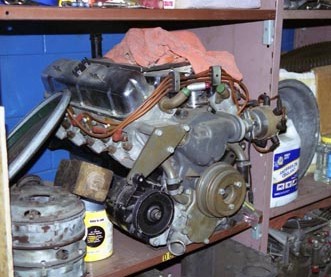
I am not permitted to tell where and when I saw this engine but according to the information I obtained this is one of the original special 1963 Fairlane racing engines used in the 1963 Lotus Powered by Ford program. (photo HG)
One year later the improved Fairlane block was fitted with DOHC cylinder heads with four valves per cylinder. By then the old Offy was doomed, or so it seemed.

Derived from the Fairlaine engine block but fitted with purpose-designed DOHC cylinder heads, an example of the Ford Quadcam racing engine used in the mid-sixties. (photo HG)
Louis Meyer believed so anyway so he sold out to his partner Dale Drake who went along on his own. Louis Meyer became the representative for Ford to distribute and maintain their Indy V8 engines!
Drake Engineering was then approached by mechanic Herb Porter who had experimented with a 2.8-litre Offy fitted with a turbocharger. At the same time engineer Dick Jones who ran an engine shop for Champion spark plugs had done similar experiments but he had used a Roots blower. Both these efforts showed much more long-term potential and suitability for track use than the earlier attempts with centrifugal superchargers on reduced capacity Offies in primarily the early fifties and Herb Porter's earlier experiments with such a blower in the late fifties.
Drake Engineering subsequently had their long-serving chief designer Leo Goossen design their first generation of bespoke Offies destined to be either Roots-blown or turbocharged. These made their debut in 1966 but the development to become reliable and competitive contenders needed some time. During the second half of 1967, however, it became clear that the turbo Offy in particular had gained an edge over the Ford V8. Ford responded by introducing a turbocharged version of their V8 in 1968 which after a lot of work overtook the turbo Offy again from 1969 on.
Drake's major option for fighting back yet again was to make their four-banger able to withstand higher boost levels to generate more power while remaining reliable. In 1970 the two engines were on par but Ford saw the writing on the wall. Their V8 had the exhausts within the vee of the engine while the inlet was on top of the cylinder head, between the cams. Extensive testing during the design phase of the atmo versions had proven this to be the most ideal lay-out, which had been retained ever since. But for the turbo version this lay-out was less suitable and the Ford was known for having some difficulties with displacing the heat within the engine. The less complicated Offy had yet another advantage. It was built up as a crankcase with on top of that the complete cylinder blocks, including the cylinder head. There was no separate cylinder head and gasket that could become a weak point. Building up an Offy was not the easiest job to do because of that construction but over time it became an advantage when boost levels went up higher and higher. As long as cylinder block cooling was adequate, the boost level that the Offy could deal with was increasing and increasing, and with it the power outputs.
... and why such a Vaillante-Ford halfbreed was impossible to create in the real world
During the second half of 1970 and early part of 1971 the balance once again shifted towards the Offy, but also because of some help. The Ford company had invested so much money in the Indy engine program by now that it was declared enough. They pulled out of the Indy racing scene, and all remaining engine hardware and facilities went over to AJ Foyt and his engine man Howard Gilbert. Without the money that Ford had thrown into the project, Foyt and Gilbert did their best to keep the V8 competitive. One proof point of that was that they warranted their work on the engine (and the lack of further Ford input) to justify the name change for the engine into Foyt V8, as clarified by the introduction of new cam cover on which the text Ford had made way for Foyt.
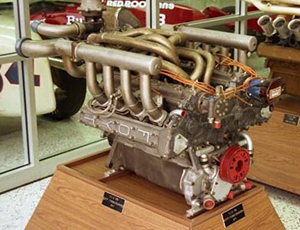
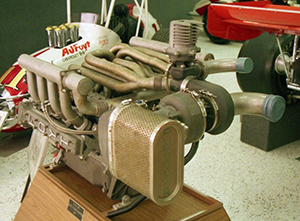
Seen in the IMS Museum, a fairly early turbocharged version of the Ford Quadcam engine. This one already has Foyt cam covers, marking it as a post 1970 version. The inlet manifolds on this example suggest that this is a version as used before 1973. (photo HG)
But after Ford's withdrawal from racing, some Ford-using teams got suspicious about the kind of customer service provided by Foyt and Gilbert, along with suspicions about Foyt keeping the best engines for his own use. With Offies ever more capable to keep up with Foyt's V8s and with nowhere near the supply difficulties, more and more teams went over to use Offenhausers. When all kind of aerodynamic trends which resulted into reduction of frontal area in order to make the rear wing as efficient as possible, the taller Offy gained another advantage over the larger V8. All of this combined made what once had been the Ford turbo V8 a less than ideal option, not in the least because there were ever more signals that AJ wanted to keep the Ford as exclusive to him as possible.
During 1972, the boost levels used on the Offy got higher and higher and with it the power outputs, up to a level that it became impossible for Foyt and Gilbert to follow that trend any longer. The V8 could tolerate some 80 to 85 inch of mercury pressure levels (2.67 to 2.84atm) and run at a reasonably level of reliability, but that was about it. More boost was possible but at the expense of reliability and so no serious option for racing. The Offy went up to 100 inch of mercury (3.3atm) and during 1973 it was clear that Offies by now had a clear advantage over the few V8s still in use.
1973 became a hallmark year for the old four-banger, now capable of producing four-figure power outputs, although the limits of what the engines could withstand was about to be reached. The 1973 Indy 500 was a near disaster with some tragedies, lots of rain and a retirement rate during the two-thirds race distance covered that made everyone think. Drastic rule changes were announced for 1974 and beyond in order to enhance safety, reduce power and speeds.
While all of this took place since 1971, Ford was no longer involved with the engine. In other words, when Vaillante returned to Indianapolis in 1974, there was no Ford factory-supported participation like once in the past anymore. The only options for factory-delivered, let alone factory-supported Ford engines was Ford having found a few left-over engines somewhere in their possession or new owner AJ Foyt would have had to have played a part in making that possible by having what were by now pretty much 'his' engines renamed into Ford again, and with the blessing and maybe even support of Ford supplied to an opponent of AJ.
Knowing the kind of personality AJ Foyt was in the mid-seventies, there was no way that he wanted to be part of a deal to enable another team to use factory-supported engines he had to supply to begin with, and certainly not when the team he had to provide with engines had a strong foreign background. Maybe and just maybe, if he had been able to benefit from the kind of factory support that Vaillante was to get, he might have given it a thought.
But even then, if there was one year in which AJ would not have shared any of his engines with anyone else, it was 1974 and the immediate years after. Let's see why.
Rule makers showing who is 'their favorite son'?
No doubt that rule changes regarding the cars were necessary after the disastrous 1973 Indy 500. For the upcoming Pocono 500-miler the width of the rear wings was instantly reduced from 64 inch (162.5cm) to 55 inch (139.7cm) to restrict their efficiency and thus the cornering speeds of the cars.
Fuel tank capacity went down from 70 to 40 gallons (265 to 151.4 litres) and tanks were only permitted on the left side of the car with the exception of a small 2.5-gallon pick-up tank. The fuel allocation for the distance was reduced from 375 to 340 gallon (1420 to 1287 litres).
For the 1974 season some more changes were announced. The width of the rear wings was reduced even further to 43 inch (109.2cm) and fuel allowance went down to 280 gallons (1060 litres). But USAC rule makers had one last trick up their sleeve that, when pulled, looked like a kind of proclamation of who was their preferred competitor.
In order to reduce the power output of the engines, the turbo boost was limited to a maximum level with mandatory pressure relief valves being installed onto the manifold systems of the engines to achieve such. The maximum boost level selected was a value of 80 inch mercury, the kind of value that was still attainable for a serious period of time and thus during a race for AJ's V8. Offenhausers did not have the slightest trouble to cope with such a boost level but on 80 inch they were some 50 to 75hp down on AJ's engine that was almost exclusive to him!
Within the space of months the balance had entirely shifted to favour Foyt's V8, and due to his exclusive rights to the engine to him personally as well. From an also-ran due to his equipment to a towering high favorite the following year, again due to his equipment...
The only things that could save the races for Offies was the fact that reliability on 80 inch for the V8 could be an issue while the Offies outnumbered the Foyt cars big time.
With the new-for-1974 engine rules installed, it's needless to say that any other team with access to well-maintained and serviced Foyt/Ford V8s all of a sudden entered the Indy 500 with a big power advantage on the majority of the entrants. If the chassis was sorted out properly as well, you were among the favourites at Indy that year. But there weren't that many V8s around that weren't in AJ's possession anymore.
Implications for the Vaillante Indy Special
As for Vaillante in 1974 getting an engine named Ford, based on what once was indeed a Ford engine, it must be clear by now that such was impossible to take place. Obtaining Quadcam engines that somehow were part of the AJ Foyt stock was also out of the question. The power advantage Foyt had with his V8 over the Offy opponents was at its largest in the early years after the 1973 rule change. And no way that AJ was going to share such an advantage with anybody new, let alone with what was effectively a factory effort from a foreign car builder. A few years later, another foreign manufacturer wanting to participate at Indy with their own engine found out in a bitter and personal way how AJ felt about intruders from abroad and the power and might he could generate within the USAC ranks to get things his way. Although it must be admitted that it is very likely that a number of other USAC entrants didn't mind AJ flexing his muscles and wielding his input to prevent an unwanted situation for him. It's just that AJ's chances of influencing USAC's decision-making to his (and their) liking were better than anyone else's.
It must be clear by now how impossible the existence of a Vaillante-Ford with or without AJ's assistance had to be. Nevertheless, in whatever most unlikely scenario the company managed to get hold of good examples of the V8 engine 'once known as Ford' it would have made Steve Warson and his Vaillante an instant top contender, assuming that the car's chassis was right. But since in the story Steve won the pole, the question of the chassis being any good is answered with that observation.
Another observation: in the album it becomes clear that Steve also remains near full-time with the Vaillante F1 team. In the last race of the album when the F1 title is decided, Steve is still in a position to win the world title, suggesting that the Vaillante Indy Special was literally an Indy Special driven in a single race that year. If it was driven by Steve or anyone else in the other USAC championship events that Indy was a part of is not mentioned. Maybe even more remarkable to point out that Steve had managed to remain in touch with the other F1 world title candidates still left given the fact that he had driven one less race than all the others, and in the light of what happened to him at Indy (more details on that later on) had remained competive after missing that race and his Indy experience. Graton describes Steve's second half of the season as a strong one.
Steve Warson's opponents and the inspiration for them
As mentioned already, the album Champion du Monde contains a number of cars that did compete in the 1974 season in both F1 and endurance racing. For the Indianapolis adventure, I think it's difficult to determine whether author Jean Graton had access to photographic sources and other material of the 1974 race. There is at least one piece of evidence, maybe two, that suggests that he had access to at least some material. I am however near certain about his using 1973 material. For example, there is a drawing of the race winner sitting on the Pace Car for his lap of honour. The 1974 pace car was an Oldsmobile Cutlass Targa-style convertible. However, the car drawn by Graton is a full convertible of tremendous size, very reminiscent to the car that did the job in 1973 which was a giant Cadillac Fleetwood Eldorado Convertible. The car drawn in the album certainly has some similarities with the '73 Caddy.
For the cars in the race scenes there is again (much) more evidence for 1973 inspiration than actual 1974 cars. Now it needs to be said that there were not that many entirely newly designed cars entered for 1974. Most cars were existing cars modified to the new rules and even most brand-new cars were either updated or refined versions of existing models. For example, McLaren built only one new car for 1974 but it was typed M16C/D and the basic chassis was near identical to the Cs built in 1973, save the necessary modifications due to rule changes. But in 1974 the bodywork and rear-wing support on the McLarens had been changed quite a bit, making the cars look sleeker and much more attractive. Most of the M16s looked different from the cars used in the three years before since the M16 had made its debut. Yet all except one of them were older tubs.
AJ Foyt had debuted a new Coyote designed by Bob Riley in 1973, and in 1974 a refined and better looking, more streamlined updated version was introduced. The majority of the teams still used variations of the Eagle introduced in 1972. It really required eagle eyes in order to see the detail differences between a '72 and a '73-built chassis as most of the '72 tubs were modified to accept the '73 modifications. According to data I have found there were indeed new Eagles built for 1974 as well but once again these were difficult to separate from upgraded older chassis used for another year of duty.
Let's have a closer look at the cars other than the Vaillante that appear in the story.
Apart from Steve's Vaillante, there are two other imaginary car-and-driver combinations in the field of Graton's race: Steve's arch enemies Sam Hawkins and Bob Cramer are also in the race but unlike the previous 'Classic Graton' Indy 500 adventure (Suspense à Indianapolis) these two men do not drive for the Texas Drivers Club anymore. Instead, they drive for an organisation guided by another arch enemy of Steve Warson and the Vaillante team named the 'Leader', and his team fields cars with the same name, in this adventure driven by the two former Texas Drivers.
When looking at the other cars in more detail, comparisons can be made between the cars actually entered and raced in 1974 since that was supposed to be the year of the adventure taking place. But since it is quite obvious that most of the drawings are inspired on 1973 cars, the same comparisons can also be made with cars entered and raced in 1973.
Looking things over, we end up with Graton having compiled a mix-up of a few actual 1973 cars and one car that was correct for both 1973 and 1974. But several cars appear using a number that in reality had been assigned to other teams and drivers. So here's an overview of the Graton cars compared with the actual cars that used the numbers in the years 1973 and 1974. In all the following stats [R] stands for a car that was part of the race. [DNQ] stands for a car that was not in the actual race.
Starting with the numbers on the cars used by the imaginary drivers in the story:
| # | Graton | 1973 | 1974 |
| 8 | Steve Warson, Vaillante | Bobby Unser, Olsonite Eagle [R] | Gary Bettenhausen, Penske McLaren [R] |
| 15 | Bob Cramer, Leader | Peter Revson, Gulf McLaren [R] | Al Unser, Eagle [R] |
| 16 | Sam Hawkins, Leader | Lee Kunzman, Eagle [R] | Mario Andretti, Eagle [DNQ] |
| 22 | Jo Barett, Eagle | Patrick Racing Eagle, backup [DNQ] | - |
The number 8 used by Steve Warson has one statistic exclusive to the #8. Of all numbers used in the very first 500 (in 1911) the number 8 had the longest streak of race starts since 1911. The first race without a number 8 was in 1954 and to some extent it could be predicted that despite a car with that number being entered and qualified it was bumped from the field. But since the car numbered 8 was by that time already said to be jinxed, let's say that the streak of race starts for the #8 broken that year was a by-product of yet another occurrence of the Novi Jinx...
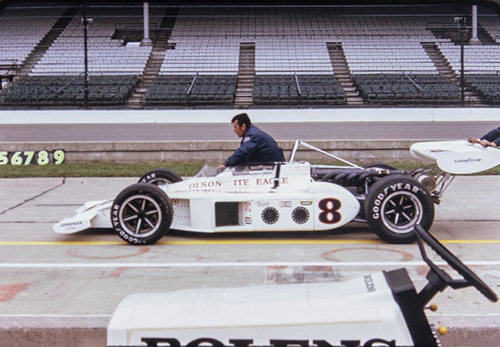
No way of course that an imaginary car using the #8 can be pictured. But in 1973 the number was used on this car, one of the factory Eagles fielded by Dan Gurney. This car was driven by Bobby Unser. The strange thing is that Bobby and the car he drove are mentioned in Champion du Monde but Jean Graton gave Bobby the number #48. (photo copyright Jim Edwards Collection, provided by Bill Ashby, used with permission)
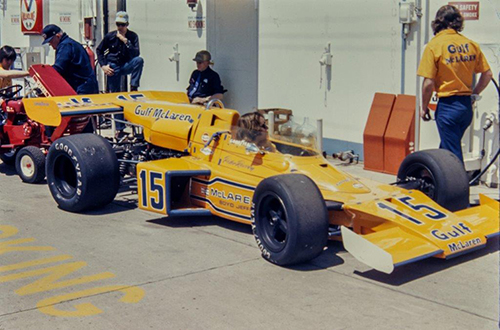
What is valid for the #8 in the Graton-drawn story is also valid for the #15. In the script Graton gave the number to a Leader entry. In the real events of 1973 the #15 was allocated to one of the factory McLaren entries. This is the car driven by Peter Revson in regrettably what was to be his final Indy 500. Revson had a fatal accident in early 1974 with a Shadow F1 car at the Souh-African Kyalami track. (photo copyright Jim Edwards Collection, provided by Bill Ashby, used with permission)
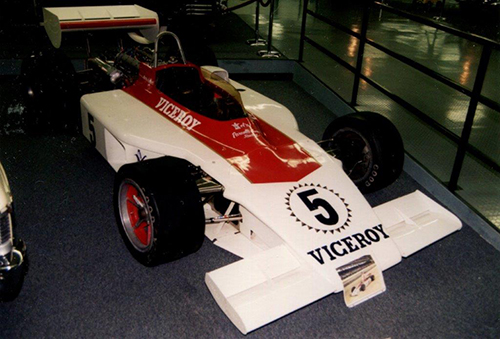
The album that supposedly took place in 1974 appears to feature only a very few cars that could have been inspired by 1974 photographic images. The #15 and #16 in the album were imaginary cars, the two Leader entries. In 1974 the real #15 and #16 also belonged to one team, both being Vel Miletich Parnelli Jones entries, both of them Eagle-Offies, the #15 was qualified and raced by Al Unser Sr. The #16 was assigned to Mario Andretti but he did not qualify that car but instead raced with this one, a sister team car. But apart from the numbers, this #5 gives a good indication as of how the real 1974 #15 and #16 must have looked like. The #5 is seen here in August 1994 in the St Louis car museum. Over the years this is, apart from the race-winning car, one of the very few restored and preserved cars that I have ever seen in its 1974 colours (photo HG)
The following numbers used by Graton have a match with either a 1973 or 1974 car, matches are in bold. An [R] identifies a car that was in the race, [DNQ] stands for a car entered but not qualified for the race.
| # | Graton | 1973 | 1974 |
| 14 | AJ Foyt, Coyote | AJ Foyt, Coyote 73 [R] | AJ Foyt, Coyote 74 [R] |
| 48 | Bobby Unser, Olsonite Eagle | Jerry Grant, Olsonite Eagle [R] | Bobby Unser, Olsonite Eagle [R] |
| 44 | ------, Eagle | Dick Simon, Travelodge Eagle [R] | Dick Simon, Travelodge Eagle [R] |
| ?5 | ------, Eagle | 35, Jim McElreath, ChampCar Enterprises [R] | - |
| 5 | ------, Sunoco McLaren | Gary Bettenhausen, Sunoco McLaren [R] | Mario Andretti, Eagle [R] |
| 9 | ------, MVS Eagle | Sam Sessions, MVS Eagle [R] | Lloyd Ruby, Eagle [R] |
Car ?5 is a two-digit numbered Eagle of which the decimal digit is not visible. The decorations, however, match near perfect with the actual 1973 Eagle #35 car.
For the #14 Foyt-driven Coyote the match is listed for the 1974 car. This is because the drawings by Graton look most like the 1974 version of the car, the 1973 had certain features that do not appear on the Graton-drawn version of the car.
For the #48 Olsonite Eagle the match is listed for the 1974 car because the Graton car consists of most details part of the 1974 #48, down to the correct driver.
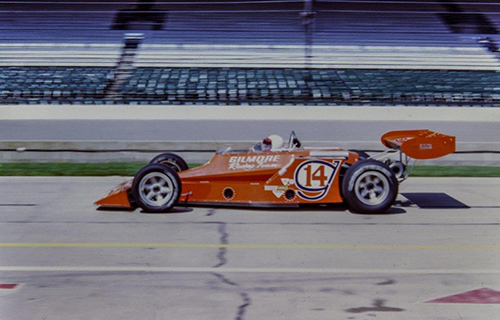

The #14 was by now the regular number for AJ Foyt’s primary car. He rarely used another number after his first use of the number in 1967 when he won the race with it. Winning the race in 1973, despite a brand new car of a revolutionary design was not very likely for AJ. In fact, once qualifying was over that year he was the next to slowest qualifier. Have a good look at AJ's helmet in this image! Do you notice what's special about it? (both photos copyright Jim Edwards Collection, provided by Bill Ashby, used with permission)
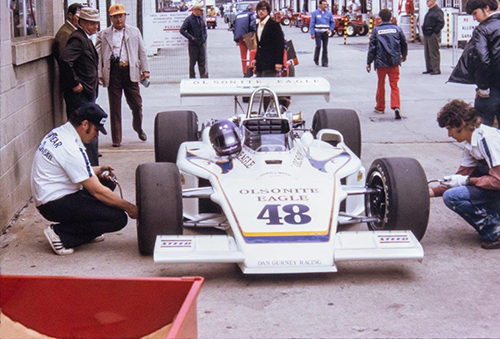
In 1972 the #48 had been used on a factory Eagle-Offy known as the Mystery Eagle driven by Jerry Grant. Although he finished the race that year, all his laps after the last fuel stop were taken away from him since he had been refueled by a wrong fuel supply tank. In 1973 Jerry was back with the Eagle factory team and again used the number 48 but this time with Olsonite sponsorship. (photo copyright Jim Edwards Collection, provided by Bill Ashby, used with permission)

In his album, Jean Graton assigned the #14 and #48 to the correct drivers and cars that used these numbers in the 1974 race, as a detail from a drawing of the album proves. (page 18, second of three drawings) The #48 Eagle still looks a lot like the large rear wing 1973 version, although the #14 Coyote does look different from the real 1973 car shown above. (scan image copyright Jean Graton/GratonEditeur/Dupuis)

This is a picture of the real 1974 Coyote #14 as raced by AJ Foyt that year. It was a refined version of the type of car introduced the year before. Look closely and one can see that the radiator housings in front of the rear wheels and the ducting of the inlet manifolds are much like the ones on the Coyote in the drawing of Jean Graton. This type of Coyote became a signature car for Indy in the mid-seventies. (photo copyright Jim Edwards Collection, provided by Bill Ashby, used with permission)
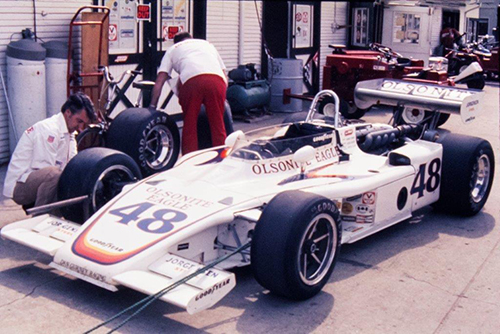
And to be entirely complete, here is an image of how the 1974 #48 Olsonite Eagle-Offy driven by Bobby Unser looked like. It is not very visible but the most important difference apart from a few coloured stripes is that the '74 car had a much narrower rear wing. (photo copyright Jim Edwards Collection, provided by Bill Ashby, used with permission)
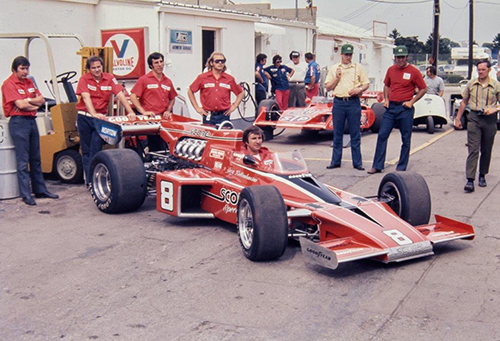
And finally, in the Graton drawing, with Foyt and Unser shown already, we can see the front of a third car in the right top corner. It is numbered 8 and so it is the Vaillante of Steve Warson. But the true #8 of the Indy 500 in 1974 was this car, a Team Penske-entered McLaren M16C driven by Gary Bettenhausen. (photo copyright Jim Edwards Collection, provided by Bill Ashby, used with permission)
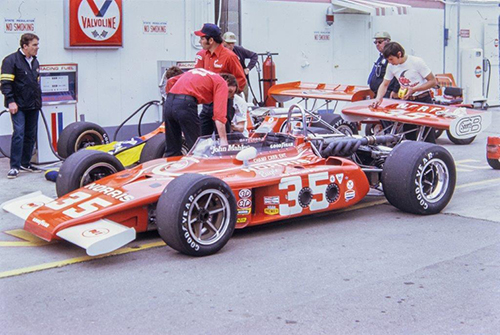
The number on one of the Eagle-Offies that appears in the novel is difficult to read if it comes to the decimals. But other decorations on the car suggests that the inspiration of the ?5 car in the drawing is inspired by this particular car. This picture was taken early in the month when John Mahler was the driver. It was, however, qualified for the race by veteran Jim McElreath who was the slowest qualifier. (photo copyright Jim Edwards Collection, provided by Bill Ashby, used with permission)

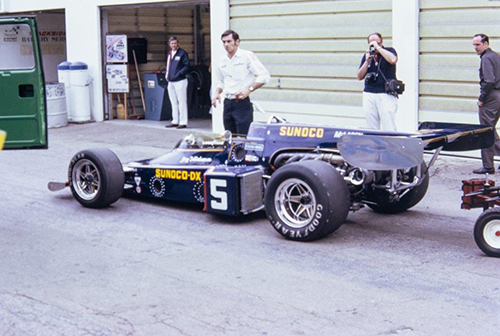
Another car that appeared in the novel is a copy of the true contender in the 1973 race using that particular number 5. This was one of the Team Penske entries that year driven by Gary Bettenhausen. This car-and-driver combination performed a statistic oddity that year. Bettenhausen in #5 had qualified fifth fastest and was classified fifth when the race of 1973 was red-flagged forgood due to rain. (photo copyright Jim Edwards Collection, provided by Bill Ashby, used with permission)
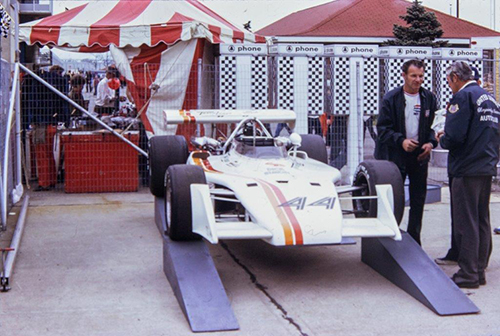
In both 1973 and 1974 the #44 was carried by the same car, driven by the same driver. The type 1972 Eagle was the most familiar kind of chassis used but it was only a minority that used something else than Offy four-cylinders. This was one of the few Eagles that used a Ford/Foyt V8 engine. The car was owned and driven by Dick Simon. (photo copyright Jim Edwards Collection, provided by Bill Ashby, used with permission)
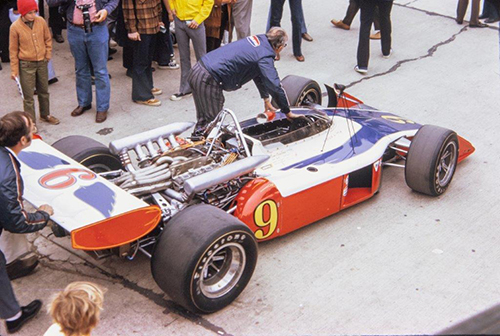
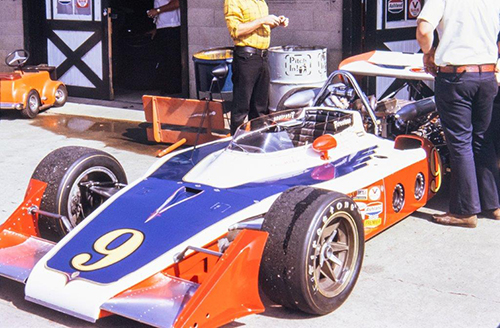
Coincidence or not, but the second car that makes it appropriate to include a part of a drawing as it appears in Champion du monde since it is inspired by an original 1973 car is the second and last Eagle-Foyt in the 1973 race! MVS was the abbreviation for the triumvirate of local business men that owned the team fielding this car. Most famous was Dick Sommers (the S of MVS) who had his years as race car owner told in an entertaining biography named Eddie called me boss. (Sommers was co-owner of the last two race cars driven by Eddie Sachs.) In 1973 Sommers' co-owned Eagle was driven by Sam Sessions. (photos copyright Jim Edwards Collection, provided by Bill Ashby, used with permission)
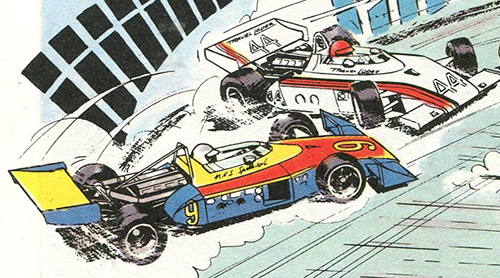
Another part of a drawing from a Graton album. The drawing can be found on page 19, top left corner. Featured here are both the Ford-powered type '72 Eagles that qualified for the 1973 Indy 500, although the drawing doesn't give clear indications that this were two V8-powered cars. However, they did not crash in the race. Sam Sessions in the #9 was an early retirement, Dick Simon in the #44 retired later on. The names on the cars as well as their colour schemes with the corresponding numbers suggest strongly that Jean Graton might have seen colour pictures of the actual cars and used them as inspiration. (scan image copyright: Jean Graton/GratonEditeur/Dupuis)
Finally, here the cars that appear in the story, identifiable or not, and the match they had with cars entered in either 1973 or 1974. An [R] identifies a car that was in the race, [DNQ] stands for a car entered but not qualified for the race.
| # | Graton | 1973 | 1974 |
| 3 | ------, 1973 Gulf McLaren (type M16C) |
Roger McCluskey, Hopkins McLaren [R] (1971 type M16A) |
Johnny Rutherford, 1974 Gulf McLaren [R] (type M16C/D) |
| 10 | ------, McLaren Hybrid | - | AJ Foyt, Coyote 74 backup car [DNQ] |
| 33 | ------, Eagle | McLaren, Dayton Walther entry (did not arrive) | McLaren, Dayton Walther entry (did not arrive) |
| 41 | ------, Eagle | Joe Leonard, Parnelli backup car [DNQ] | Hopkins Racing entry [DNQ] |
| 72 | <-----, Parnelli VPJ2 | - | - |
| 75 | -----, ?? | Greg Weld, Kingfish STP entry [DNQ] | - |

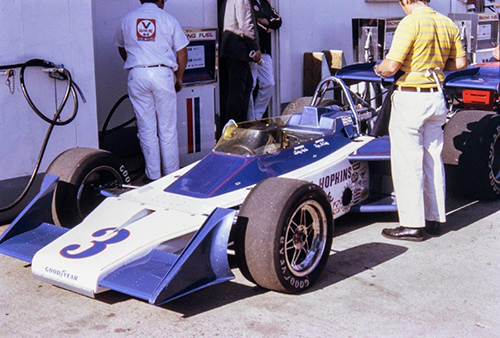
For sure, the number used by Graton about which the most can be told is the #3. In Champion du monde the number is allocated to what by all means appears to be a fairly accurate presentation of a Gulf-sponsored factory McLaren such as the #15 of Peter Revson shown already and seen here another time from another angle. The true #3 of 1973, however, was another McLaren, chassis M16A-2 built in 1971 and used that year by Peter Revson to win the pole. In 1972, it went to the Lindsey Hopkins stable and became the primary car for Roger McCluskey in the 1973 season. McCluskey was classified third after the red flag had ended events for that year. Later on in the year, Roger won a 200-miler at Michigan and at the end of the year it occurred that he had gained the most points over the entire season and thus was crowned the 1973 USAC champion. This particular McLaren was remarkable among all others because it was often the only one that used the kind of front wing seen here. It could be found on several Eagles too but this was usually the lone McLaren seen with this front wing lay-out. Curiously enough, colour-wise and in shape, this Lindsey Hopkins McLaren resembles the #10 car that appears in the Graton novel. That car uses the front wing arrangement as found on the Hopkins #3 but otherwise resembles a 1973 McLaren quite well, in particular behind the cockpit. (photo copyright both pictures: Jim Edwards Collection, provided by Bill Ashby, used with permission)

If Champion du Monde featured a #3 Gulf McLaren while there never was one in 1973, there was however in 1974! By then it definitely looked different from the version we saw in '73. The year before the very same chassis (M16C-5) had been the #7 that sat on the pole thanks to Johnny Rutherford. In 1974, the updated chassis made history when Johnny Rutherford won the race that year. (photo HG)
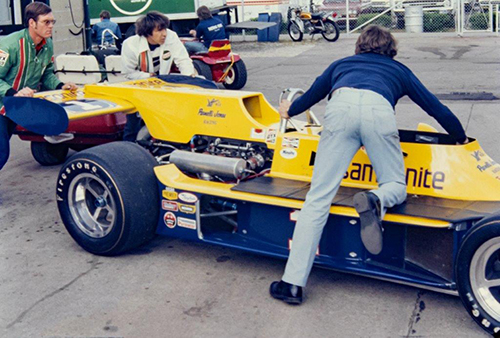
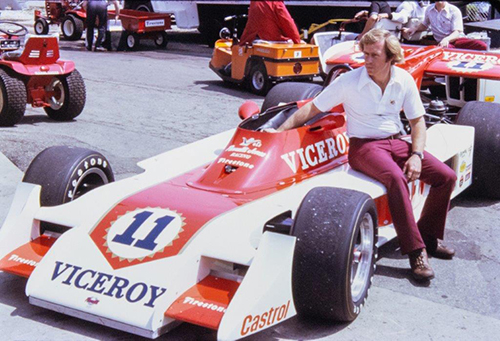
Graton drew a car numbered #72 but that number was used neither in 1973 nor in 1974. That car has details that suggests that it is inspired on a 1973 Parnelli-Offy VPJ2. Two pictures from the Jim Edwards Collection provide both the details that leads to that conclusion. The yellow #1 was the car driven by Joe Leonard, as the air intake behind the roll hoop looks a lot like that of the Graton #72. The red-and-white #11 was Mario Andretti's mount for that year and shows a resemblance with the front end of Graton's #72. (photo copyright both pictures: Jim Edwards Collection, provided by Bill Ashby, used with permission)
More about Steve's Vaillante as it became known some 35 years on
From 2009 on, the French publishing company Altaya released a series of 50 1:43 scale models of cars that had appeared in Michel Vaillant adventures. The number 48 in this series was Steve Warson's Vaillante Indy Special appearing in Champion du Monde. The information booklet with the model gave some details as to why and how Jean Graton had introduced a connection between Vaillante and the Ford Motor Company.
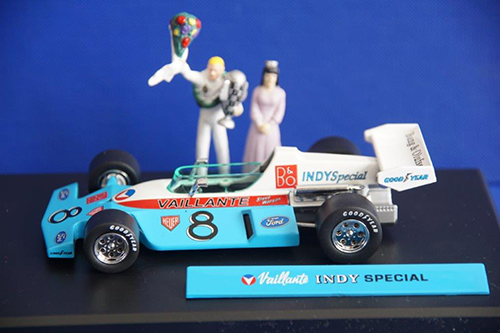
A picture of the scale model released by Altaya of the Vaillante Indy Special. (photo HG)
Some details about the Vaillante Indycar are given. It is said to be larger, heavier yet much more powerful and quicker than the contemporary F1 cars, weighing in at some 620kgs and having some 800hp while F1 cars of the day were some 550kg with some 500hp.
The research on the actual Indy situation by the authors of the info booklet appears to be kind of shabby. It is mentioned that the Vaillante is powered by a Ford engine but the engine is said to be a derivative of the Cosworth engine! Not the slightest hint to its real origin that goes all the way back to 1963 as mentioned early on in this piece.
Not that an Indy version of the Cosworth was entirely impossible by the way. The very first talks about such an engine already took place in 1968 when it was considered an option for the latest STP-sponsored Lotus Indycars. These eventually became the legendary turbine-powered 4WD type 56s. The very first examples of turbocharged Cosworths did eventually appear in the year 1975. But there are some rumours about work on such engines having started in 1974 already. So perhaps, perhaps, a turbocharged Cosworth could have existed in 1974 already, but the drawings by Graton leave little to no question about the real heritage of the Ford engine used in the Vaillante.
Besides that, Vaillante competed in F1 with its own engines, so why use a modified version of an engine used by their F1 opponents? Couldn't they have developed a turbocharged version of their own F1 engine? If not, for what reasons?
There is, however, something to be said for Vaillante putting their faith into an existing Indycar engine, supposedly available already. As explained, the links made in the past in the albums warranted the use of a contemporary descendant of the engine formerly known as Ford, logical and possible or not.
The compilers of the Altaya publication are even more questionable in the seriousness of their research on 'Indy in the mid-seventies' with their comment in the booklet about "The spies having been unable to observe if the car was only rear-wheel-driven or fitted with 4WD." Given the doubts, the Altaya people presume the car to be rear-wheel-driven only after all.
It becomes clear how embarrassing such a comment is when we remember that USAC (the organisers of the Indycar championship back then) had outlawed 4WD technology since 1970, having announced the upcoming rule change in early 1969 already!
By the way, although the actual model looks nice at first sight, when taking a closer look a major flaw can be found: the wheelbase is shorter than that of the car in the story. The space where the 'length' in the car is missing becomes obvious when looking at the car more thoroughly, as the rear axle is put too much forward, so much more forward in fact that the model doesn't appear to have a flywheel on the engine and no clutch between engine and gearbox anymore. The spool and rear axle (Indycars didn't use a differential but a spool) is located over there on the model.
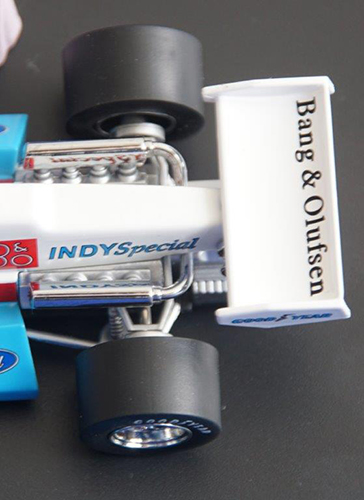
A close-up of the model as seen from above. As can be seen, the rear axle is located at what has to be the flywheel and clutch part of the entire driveline. (photo HG)
Of course, how can a 3D model of a car that only exists in a graphic novel be incorrect? Nonetheless, this is a basic flaw on any car model resembling something inspired by the reality of the time.
The final comparisons between the novel and the reality
I have not yet mentioned the biggest reason why the scenario that Jean Graton had created and as it unfolded at the track was absolutely impossible to have taken place in reality. No matter the differences between the novel and reality already mentioned, even if we overlook all of those, there is one thing that Graton did not allow to happen in his scenario.
Up until now I have not told much about the race as it takes place in the story, but now is the time to do so.
Some of Steve's most serious opponents are listed by name: some of them are existing drivers, drivers from the period, even Indy winners. His two arch enemies Cramer and Hawkins are mentioned as well as a South African rookie driver named Jo Barett who will start the race as fourth. Yet somehow, Steve was so occupied with the love story developing not to his liking and all practice and qualifying that he has entirely missed out on meeting Jo Barett in person. Something which on second thoughts he has his regrets about.
Then the race itself. Of course, like in the two other Michel Vaillant Indy adventures published until that moment it is pointed out how accidents at Indy are often quite spectacular and frequent. Steve remains in third position and keeps the leaders in sight. Halfway into the race he takes the lead and appears to head for an otherwise uncontested victory but in the final stages of the races he is all of a sudden at risk of losing his lead when Jo Barett launches a do-or-die attack. Fortunately for Steve, with less than a lap of the race to go, Barett's engine blows up and Steve wins the race after all. The Victory Lane ceremony takes place and then it happens.
When heading for the victory lap on the Pace Car, Jo Barett still wearing a helmet passes by to shake Steve's hand. Barett then takes off the helmet and to his utter surprise Steve finds out that Jo Barett is the alias of his idolised love Ruth who stands in front of him in racing overalls and with a helmet in her hands!
Ruth gets the time to reveal the truth to Steve that she is a race car driver herself and tells Steve that they can no longer see another while each of them is pursuing their own career. A flabberghasted Steve is then dragged to the Pace Car for his victory lap but his dreams are shattered and his life is in turmoil.
The story as Jean Graton drew it sees much 'adjusting' of the Indy 500 and its traditions into a manner that made it suitable for him to tell the story of lady killer Steve Warson eventually to be left fooled and in a state of shock. In doing so, the actual process of qualifying had been altered by Graton entirely.
In the story, Steve had qualified for the pole the day before we meet him for the first time, which by all means should have been May 25th. In reality, the pole was handed out two weeks earlier, on May 11th. There was a second day of qualifying one week later.
Qualifying at Indy meant that drivers had to drive four laps with the track entirely to themselves, each and everyone waiting for their turn on the pitlane. In 1974 it meant that the drivers among the fastest 33 drivers who made the field with their time set on Saturday May 11th were ahead of all drivers who set their time one week later.
Now, Jo Barett had qualified fourth fastest, right behind Steve on the grid.
In theory it is possible that in 1974 it could have ended up in a situation that the pole sitter and the fourth fastest driver had qualified on different days. But such scenarios needed quite a lot of unusual circumstances to happen. So unusual that it is more likely to assume that Steve and Jo had qualified on the same day, so in the story that would have been Saturday May 25th. Also so unusual that I rather won't go into such scenarios since it distracts from the main story.
Anyway, with Steve and Jo most likely having qualified on the same day, it is hard to imagine that Steve never had a moment or situation that enabled him or maybe even forced him to have a glance and some kind of brief meeting with Jo Barett before the race.
Then at least one scene in the album taking place after the race is impossible to envision as ever having happened, as Steve was confronted with the truth about Jo Barett and Ruth while the victory rituals were still taking place and had yet to be finished. No way that any other driver (or anyone else for that matter!) could have interrupted that victory protocol at the Speedway in order to have some kind of a private discussion about non-racing-related manners with the fresh winner of the Indy 500 that had just finished.
But apart from the dates of track action as they appear in the story being incorrect, there is one other, much more important reason why a race like Jean Graton allowed to take place in his album would never have happened at the Speedway. I think it is kind of obvious in which direction I have to continue this writing.
One of the things the month started with at Indy was the physical examination of the drivers who were either entered for the race or intended to make themselves available for taking up a drive should such be offered to them. The local press always knew which drivers had taken their physical and were available and ready to go.
Any need to continue?
The driver known as Jo Barett would never have been able to get into a car, let alone in the race if not being cleared by the medical staff. And what are the odds of the medical staff failing to notice that they were examining a woman? And this remaining a secret for literally absolutely everyone? And then, a newbie (rookie in the local terminology) at the track being entirely ignored by the local press and allowed to hide away for press and just about everybody else on the track and thus preventing his/her big secret becoming public knowledge? And all of that for the entire Month of May? Because can anyone believe that Steve was so much living in his own world that he had failed to notice entirely all that time what the entire Indy community had to know by then: that Jo Barett was female? Can we imagine any likely scenario that people at the track already knew with Steve having missed all this entirely?
The Month of May was and still is the highlight of the year for the local press in the state of Indiana, in particular for the local newspapers of Indianapolis. At that time these were the Indianapolis News and the Indianapolis Star. The manner in which they thoroughly covered activities and gossip at the track was second to none. The chance that they had missed out on the fact that a woman had qualified and raced in the Indy 500 was also second to none. In case a driver would have behaved like an enigma, uncatchable, invisible, it's certain that (s)he still would have received loads of publicity. In other words, it was impossible that Jo Barett would have escaped all media attention without at least enough of a stir surrounding that the fact that Jo was a female driver. Had Jo managed to pull that off, that would perhaps even been more of an achievement than winning the actual race!
And even if it was known one way or another already that Jo Barett was female, how in the world could that have been known within the entire Indy community, with somehow Steve Warson as the only person not to know the truth?
And then remember that the Indianapolis Motor Speedway was a most female-unfriendly location. The pit lane had been forbidden for women for a long, long time. Even the few female car owners that tried their luck at Indy were not permitted to enter the pit lane, and same applied to female time keepers. One year when French driver Louis Chiron came over to drive at Indy and brought along his girlfriend Alice 'Baby' Hoffman who was renowned in the European racing scene for being a excellent time keeper, even she was not permitted on pitlane. Yet another kind of proof that one way or another 'Jo Barett' had to hide the fact that she was female for absolutely everyone except perhaps her team and crew members, who then also had to keep the secret as well.
Another thought, it was almost impossible to have the victory ceremony interrupted in a manner as Jean Graton described. But since we do know by now that it was impossible for a woman to have entered the pitlane, and realising how much press members were attending the victory ceremony, what kind of response could have been expected if a scenario as Graton created had truly unfolded? The revealing of the fact that a woman had kept her identity a secret for the press and just about everyone else at the Speedway while almost winning the Indy 500? It's not impossible for the attending press that this was a bigger story to deal with than the fact that Steve had won the race.
Regarding the media at that time, there was no live coverage of the race in those days but a tape-delayed report on one of the big networks. There was, however, a live race report over the radio made by the IMS Radio Network headed by the legendary Sid Collins. These broadcasts were made available to every local radio station interested and willing to pay. But when tuned in to the right station one way or another, it was possible to get a live radio race report.
You can find the live reports of Indy races as covered by the Speedway Network on the Internet now. When listening to the scenes in Victory Lane after a race it becomes even more difficult to envision the scenario as drawn by Jean Graton. Imagine the kind of report the Speedway Network reporters (most likely equally stunned) would have made about the scenes after the Victory Lane celebrations when Ruth revealed the truth about herself as appearing in Champion du Monde.
What Jean Graton did not allow to take place in this Indianapolis adventure was something like what we saw for the first time in 1976, the year when female driver Janet Guthrie was entered for the race driving for Rolla Vollstedt's team. The publicity and media attention she generated was tremendous and would have made many a driver jealous. Janet was fighting the odds and pre-justice and a number of drivers didn't want to see her race despite the fact that she definitely had the credentials to be taken seriously. Sadly enough for her, the Vollstedt-Offy she drove was too old and too slow.
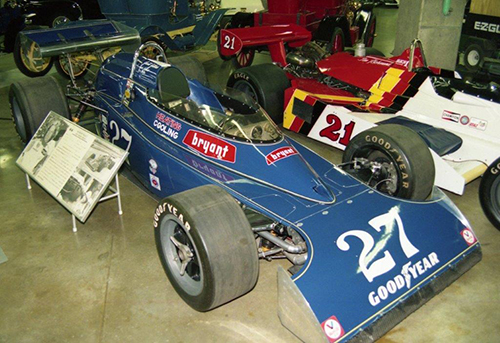
This was the Vollstedt-Offy that Janet Guthrie drove in 1976 in an attempt to become the first woman to qualify for the Indy 500. The car was too slow and there were too many problems for the team to overcome. (photo HG)
During the final weekend of qualifying, however, Janet was given the opportunity to practice with one of AJ Foyt's backup cars, one of the most recent Coyotes. Curiously that was the car entered as #1. Since AJ was the reigning National Champion he was entitled to use the number but he preferred to continue using his by now more familiar and traditional #14 on his primary car. Janet was practicing fast enough and if only AJ had decided on letting Janet qualify the car and put it in the race, she actually might have got it done. Instead, AJ pulled the plug after all and concentrated his team's efforts onto his own car. And by not having another Coyote qualified in 1976, AJ achieved something he had been striving for since 1971: exclusive use of the former Turbo Ford V8. At last, his own Coyote was the only car in the 1976 race that made use of such an engine.
One year later in 1977, however, Janet did qualify for the race, causing quite a stir among all the traditional fans and other people with interest for the race who wondered how Tony Hulman would instruct the gentlemen at the starting grid to start their engines! For a number of reasons, 1977 was a historical year in Indy history with so many historical feats that the very first woman in the race was a fact that almost got lost among all the other historical moments. Regrettaby Janet's race was cut short due to mechanical issues.
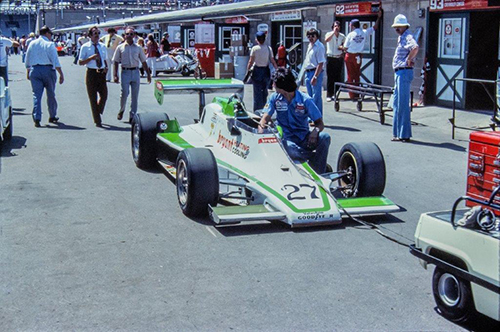
Janet Guthrie qualified this Lightning-Offy for the 1977 race and became the first-ever woman in the race. (photo copyright Jim Edwards Collection, provided by Bill Ashby, used with permission)
Janet would eventually qualify for the races at Indianapolis in the two following years and gained a lot of respect in 1978 with a very creditable ninth place, despite racing with a fractured wrist.

Janet Guthrie used this Wildcat III-DGS in the 1978 race to score what for a long time was the best finish ever for a woman in the 500. The DGS was an variation on the Offenhauser four-cylinder engine that was deemed to have the most ideal valve angle configuration possible. It was introduced in 1975, at first exclusive to Pat Patrick who had financed the final design and production. It could give the Ford-Foyt V8 a tough time but was no match for the Cosworth DFX once that engine had been sorted out. Patrick Racing had also built the Wildcat chassis. (photo HG)
In later years more female drivers made it into the race, with some creditable performances. Lyn St James won Rookie of the Year honours in 1992 after finishing 11th in what turned out to be a crash fest between yellow light periods. In 1994 she raised some eyebrows when she qualified ahead of defending CART champion Nigel Mansell.
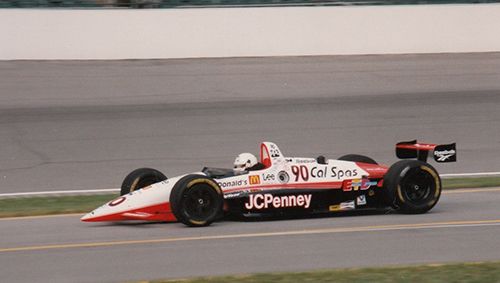
Lyn St.James surprised many people with a splendid qualifying performance in 1994 in this Lola-Ford. (photo HG)
But with respect to female drivers eventually some of the novelty wore off over time, with a possible exception being Danica Patrick. Her arrival in the IRL in 2005 made headlines and in the years that followed she gained lots of publicity as well as some decent results.
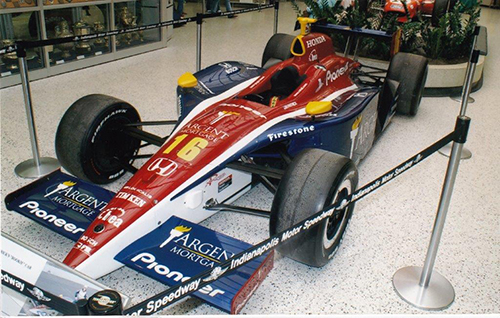
In her rookie year 2005 Danica Patrick bettered the best race result ever for a women in the Indy 500, driving this Panoz-Honda to fourth place after starting from the same spot. Here is the car seen in early May 2008. (photo HG)
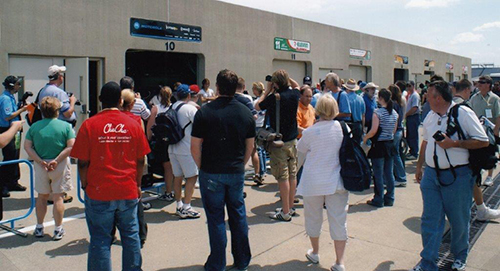
Wherever Danica went at the Speedway in those early years in her career, the public followed her. Few drivers attracted so much crowd attention as she did. Fanatic race fans might have their thoughts about the kind of crowd that she attracted and for which reasons exactly but the fact remains that Danica's presence was a major asset for the IRL in the final years of 'The Split'. This picture was taken on May 7th, 2008, the first day she was permitted to be out on the track. But on this picture she was somewhere behind all those people. (photo HG)
Let's give a few other women at Indy some credits for their memorable performances.
During practice in 2011, Simona de Silvestro from Switzerland crashed her primary car that then went on fire and as a result she had her hands affected by burns. But on the first day of qualifying she managed to gain a spot among the first 24 qualifiers on a day that every regular driver of the Andretti team failed to do so!

A woman with balls! Swiss female driver Simona de Silvestro earned tons of respect for her guts, determination and achievements by qualifying safely on the first day of qualifying in 2011 after having gone through a fiery accident which resulted in burns to her hands. She is seen here while lapping her HVM Dallara-Honda on Pole Day, May 21st, two days after the accident. (photo HG)
And in 2023, when the fastest 30 drivers were certain of a starting spot for the race, Katherine Legge took the final spot. She was the fourth and additional 'Indy only' entry by Rahal-Letterman-Lanigan Racing. Her three team mates who raced the full season all failed to make it into the fastest 30.
Which brings us back to Jo Barett in 1974.
In general one could say that being a female driver at Indy did help to generate additional interest and attention, and being the first one would have done so even more. 'Jo Barett' would have had a very difficult time to escape all of that and kept that big secret undetected until after the race for Steve Warson to find out at last who used the name of Jo Barett as an alias.
Why Indianapolis as venue for a love story to come to an end?
The story as created by Jean Graton is neither entirely accurate nor a historically correct reflection of the 1974 Indy 500. The main story of the plot is the romance Steve believed he was in and how he was pulled out of that dream at the biggest racing event in his country for an American driver at the time, right after writing history by winning that event. There were not many things left in racing that could have matched the achievement of winning Indy in the mid-seventies, both in the US and worldwide. Jean Graton selected Indianapolis as the stage for bringing the American driver among the personalities in his series to reach a summit that was almost impossible to improve upon, yet there was something else even more on the mind of this American driver than that moment of glory. While being on top of the world in his profession, he was brought down to earth in a most painful manner. That was why Indianapolis was selected as racing venue.
To some extent, the choice for Indianapolis as a venue for an event in the albums may have raised a few eyebrows. At the time when Graton created the album, the last race held at Indianapolis was the disastrous and horrendous 1973 affair. There is really not much positive to tell about that year and a number of negative sentiments about the event and its organisers and the people behind it found its way into print. If he was aware of it, Jean Graton omitted each and every suggestion and link to the aftermath of the disastrous events of that year. By the way, history appears to repeat itself because this creation by Jean Graton of an Indianapolis adventure took place after the last edition of the race had seen terrible accidents. Very much the same as what had happened when the previous Indy adventure (Suspense à Indianapolis) was drawn in 1964, right after that year's race had also seen some dramatic and nightmarish events. But for sure that the fact that Indianapolis 1974 was chosen by Graton to be part of a story is related to the larger love story taking place in two albums he was telling. The horrible '73 race and the negative publicity after that event had nothing to do with that.
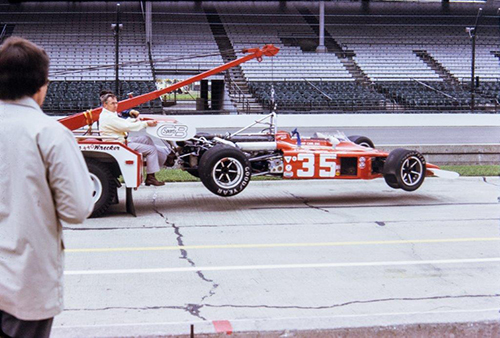
One of the cars that made it into Champion du Monde that was involved in an accident during the Month of May of '73 was the #35, when driven by the originally assigned driver John Mahler. (photo copyright: Jim Edwards Collection, provided by Bill Ashby, used with permission)

Seen here without the top bodywork and nose cose is the #44 Eagle-Foyt of Dick Simon. Both 1973 accidents that eventually were fatal for drivers Art Pollard and Swede Savage happened with Offy-powered Eagles. As can be seen, the Eagle and other most modern chassis of that era for that matter (the McLaren M16 and the Coyote) provided little to no substantial protection for the upper body of the drivers. Talking about safety, the man on the left definitely had no fears either or any idea of being in a dangerous situation, can you spot why? (photo copyright: Jim Edwards Collection, provided by Bill Ashby, used with permission)
Despite the tragic recent events, the Indianapolis 500 was still the prime 'American Racing Institute' to contend with. And as such, with the story he had in mind, Indy remained the best possible venue and location for the plot that Jean Graton created for his American hero Steve Warson. He only had to change some traditions and ignore the professionalism and dedication to the event by the local press.
But then, could there have been an alternative venue for this love story? The only race that could have challenged Indy in prestige was the Daytona 500. But to see Vaillante compete in NASCAR had happened in a previous adventure already. NASCAR wasn't the kind of racing formula that fitted well within the Michel Vaillant series, and so Indy remained the best option.
Perhaps Le Mans could have been another venue in which to put Steve up against Jo Barett, but then both drivers would have been part of a two-man team effort. This would have taken away the aspects of the two taking on each other on their own strength as happened at Indy. Besides that, Le Mans was the scenery used for the continuation of the other love story that had begun in the previous album Des Filles et des moteurs, and that love story involved one of the French personalities in the Michel Vaillant series. (A young protege of Michel named Yves Douleac, to be exact.)
Monaco then, the most glamorous of the F1 series wasn't possible since the F1 part of the album focused on the efforts of Michel Vaillant and his quest to become world champion. That takes away any thoughts of using Monaco as venue for Steve to have his heart crushed. Besides that, how would it been possible to have Jo Barett as a part of the F1 circus without it being noticed by absolutely everyone else that Jo was female?
So yes, Indianapolis simply had to be the place for this particular part of the entire album. And even if it wasn't entirely historically accurate, in the parts of Europe where the album was available in whatever language version, it was likely the publication about racing at Indianapolis that was seen by the largest number of readers. As such, the Michel Vaillant graphic novel Champion du Monde is probably among the best ways of promotion Indianapolis had in those countries at the time of its publication and the years after. And that without any inspiration from the disastrous 1973 which had put Indy in such a bad spotlight worldwide.
References
Publications
Dutch translations of the Michel Vaillant albums:
No. 1: Le Grand Défi (an English translation of this album released in 2007 was also used)
No. 11: Suspense à Indianapolis
No. 26: Champion du monde
Carl Hungness Indianapolis 500 yearbook 1973, Carl Hungness Publishing, Speedway, IN
Carl Hungness Indianapolis 500 yearbook 1974, Carl Hungness Publishing, Speedway, IN
Carl Hungness Indianapolis 500 yearbook 1976, Carl Hungness Publishing, Speedway, IN
Carl Hungness Indianapolis 500 yearbook 1977, Carl Hungness Publishing, Speedway, IN
Autocourse Official history of the Indianapolis 500 (second edition - fully revised and updated), Donald Davidson & Rick Shaffer, Icon Publishing Limited (2013)
Design & Development of the Indycar, Roger Huntington, HP Books, Tucson AZ USA (1981)
Eddie called me Boss, Dick Sommers, Warren Publishing Company, Indianapolis, IN (1979)
The Illustrated History of the Indianapolis 500 1911-1994, Jack C. Fox, Carl Hungness Publishing, Speedway, IN (1995)
Altaya: Les voitures de Michel Vaillant, no 48: Vaillante Indy Special
This was a booklet released with the 1:43 scale model of the listed car, released by Altaya France.
Websites
Michel Vaillant on Wikipedia
Vaillant fan club
Official Michel Vaillant website
OldRacingCars.com
Pictures for this write-up were obtained from the collection of Jim Edwards, currently residing in Zionsville, IN. The collection is maintained and the actual images were supplied by Mr Bill Ashby from Brownsburg, IN. I want to express my sincere thanks to both men for their most valuable support.
All other pictures are from my own collection.
